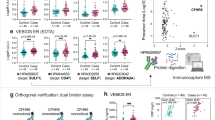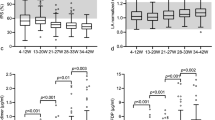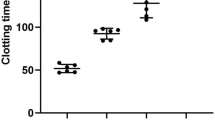Abstract
Objective:
The aim of this study was to investigate the plasma coagulation factor VII activity and its correlates in healthy Australian men.
Design:
Cross-sectional study.
Setting:
Free living subjects.
Subjects:
A total of 139 healthy Australian males aged 20–55 y with widely varying intakes of individual fatty acids.
Outcome measures:
The concentration of phospholipid fatty acids and the parameters of biochemistry were analysed by standard methods. Citrated plasma factor VII activity was measured by using the ACL 200 system with commercially available kits.
Results:
In the stepwise multiple regression, controlled for age, body mass index and dietary groups, the two most important variables of factor VII activity were selected in the forward entry model with R2=0.474 and P<0.0001 from 19 independent variables, which were significantly correlated with plasma factor VII activity in age-adjusted bivariate analysis where significance was considered at P<0.01. Plasma factor VII activity was strongly negatively correlated with prothrombin time (PT) (Std. Coeff. −0.550), and significantly positively correlated with plasma phospholipid (PL) stearic acid (Std. Coeff. 0.285).
Conclusions:
Increased factor VII activity was associated with shortening of PT. All types of fatty-acid concentrations of PLs were significantly positively correlated with factor VII activity; however, stearic acid was more potent than other fatty acids in healthy Australian men.
Sponsorship:
Meat Research Corporation of Australia.
This is a preview of subscription content, access via your institution
Access options
Subscribe to this journal
Receive 12 print issues and online access
$259.00 per year
only $21.58 per issue
Buy this article
- Purchase on Springer Link
- Instant access to full article PDF
Prices may be subject to local taxes which are calculated during checkout



Similar content being viewed by others
References
Aird WC (2003): Hemostasis and irreducible complexity. J. Thromb. Haemost. 1, 227–230.
Cenedella RJ (1994): Cholesterol and hypocholesterolemic DRUGS. In: Modern Pharmacology eds Craig CR, Stitzel RE, 4th Edition, Boston: Little, Brown and Company. pp 197–209.
Cleland LG, Proudman SM, Hall C, Stamp LK, McWilliams L, Wylie N, Neumann M, Gibson RA & James MJ (2003): A biomarker of n-3 compliance in patients taking fish oil for rheumatoid arthritis. Lipids 38, 419–424.
Cushman M, Yanez D, Psaty BM, Fried LP, Heiss G, Lee M, Polak JF, Savage PJ & Tracy RP (1996): Association of fibrinogen and coagulation factors VII and VIII with cardiovascular risk factors in the elderly. J. Epidemiol. 143, 665–676.
De Pergola G & Pannacciulli N (2002): Coagulation and fibrinolysis abnormalities in obesity. J. Endocrinol. Invest. 25, 899–904.
DeLong DM, Delong ER, Wood DD, Lippel K & Rifkind BM (1986): A comparison of the methods for the estimation of plasma low and very low lipoprotein cholesterol. The LRC prevalence study. J. Am. Med. Assoc 256, 2372–2377.
Haines AP, Chakrabarti R, Fisher R, Maede TW, North WR & Stirling Y (1980): Haemostatic variables in vegetarians and non-vegetarians. Thromb. Res. 19, 139–148.
Hornstra G (2001): Influence of dietary fat type on arterial thrombosis tendency. J. Nutr. Health Aging 5, 160–166.
Hunter D (1995): Biochemical indicators of dietary intake. In: Nutritional Epidemiology ed. Willett WC, 143–203. New York: Oxford University Press Inc. pp.
Hunter KA, Crosbie LC, Horgan GW, Miller GJ & Dutta-Roy AK (2001): Effect of diets rich in oleic acid, stearic acid and linoleic acid on postprandial haemostatic factors in young healthy men. Br. J. Nutr. 86, 207–215.
Hunter KA, Crosbie LC, Weir A, Miller GJ & Dutta-Roy AK (2000): A residential study comparing the effects of diets rich in stearic acid, oleic acid, and linoleic acid on fasting blood lipids, hemostatic variables and platelets in young healthy men. J. Nutr. Biochem. 11, 408–416.
Junker R, Heinrich J, Schulte H, Erren M & Assmann G (1998): Hemostasis in normotensive and hypertensive men: results of the PROCAM study. The prospective cardiovascular Munster study. J. Hypertens. 16, 917–923.
Kelly FD, Sinclair AJ, Mann NJ, Turner AH, Abedin L & Li D (2001): A stearic acid-rich diet improves thrombogenic and atherogenic risk factor profiles in healthy males. Eur. J. Clin. Nutr. 55, 88–96.
Li D (1998): The influence of diet on atherosclerotic and thrombotic risk factors in healthy men. PhD thesis, RMIT University, Melbourne, Australia.
Li D, Sinclair A, Mann N, Turner A, Ball M, Kelly F, Abedin L & Wilson A (1999): The association of diet and thrombotic risk factors in healthy male vegetarians and meat-eaters. Eur. J. Clin. Nutr. 53, 612–619.
Ma J, Folsom AR, Shahar E & Eckfeldt JH (1995): Plasma fatty acid composition as an indicator of habitual dietary fat intake in middle-aged adults. Am. J. Clin. Nutr. 62, 564–571.
Messmore Jr HL (1983): Automation in coagulation testing. Clinical applications. Seminars in Thrombosis and Hemostasis 9, 341–345.
Miller GJ (1995): Risk of thrombosis and the prethrombotic state. Atherosclerosis 10, 801–804.
Miller GJ (1998): Postprandial lipaemia and haemostatic factors. Atherosclerosis 141, S47–S51.
Mitropoulos KA, Miller GJ, Martin JC, Reeves BE & Cooper J (1994): Dietary fat induces changes in factor VII coagulant activity through effects on plasma free stearic acid concentration. Arterioscler. Thromb. 14, 214–222.
National Food Authority (1995): Composition of Food, Australia. Canberra, Australia: Australian Government Publishing Service.
National Heart Foundation of Australia (1994): Dietary Fatty Acids and Blood Cholesterol. NSW, Australia: Reed Business Publishing Inc.
Noto D, Barbagallo CM, Cefalu' AB, Cavera G, Sapienza M, Notarbartolo A, Davi' G & Averna MR (2002): Factor VII activity is an independent predictor of cardiovascular mortality in elderly women of a Sicilian population: results of an 11-y follow-up. Thromb. Haemost. 87, 206–210.
Oakley FR, Sanders TA & Miller GJ (1998): Postprandial effects of an oleic acid-rich oil compared with butter on clotting factor VII and fibrinolysis in healthy men. Am. J. Clin. Nutr. 68, 1202–1207.
Pala V, Krogh V, Muti P, Chajès V, Riboli E, Micheli A, Saadatian M, Sieri S & Berrino F (2001): Erythrocyte membrane fatty acids and subsequent breast cancer: a prospective Italian study. J. Natl. Cancer Inst. 93, 1088–1095.
Palmer RN & Gralnick HR (1984): Inhibition of the cold activation of factor VII and the prothrombin time. Am. J. Clin. Pathol. 81, 618–622.
Poppitt SD, Keogh GF, Mulvey TB, Phillips A, McArdle BH, MacGibbon AK & Cooper GJ (2004): Effect of moderate changes in dietary fatty acid profile on postprandial lipaemia, haemostatic and related CVD risk factors in healthy men. Eur. J. Clin. Nutr. 58, 819–827.
Prisco D, Fedi S, Brunelli T, Cellai AP, Hagi MI, Gianni R, Santoro E, Cappelletti C, Pepe G, Gensini GF & Abbate R (1996): Fibrinogen and factor VIIag in healthy adolescents: the Floren-teen (Florence teenager) Study. Thromb. Haemost. 75, 778–781.
Riboli E, Ronnholm H & Saracci R (1987): Biological marker of diet. Cancer. Surv. 6, 685–718.
Ruddock V & Meade TW (1994): Factor VII activity and ischaemic heart disease - fatal and non - fatal events. Q. J. Med. 87, 403–406.
Sanders TA, Berry SE & Miller GJ (2003): Influence of triacylglycerol structure on the postprandial response of factor VII to stearic acid-rich fats. Am. J. Clin. Nutr. 77, 777–782.
Sanders TA, de Grassi T, Miller GJ & Morrissey JH (2000): Influence of fatty acid chain length and cis/trans isomerization on postprandial lipemia and factor VII in healthy subjects (postprandial lipids and factor VII). Atherosclerosis 149, 413–420.
Sanders TA, Oakley FR, Cooper JA & Miller GJ (2001): Influence of a stearic acid-rich structured triacylglycerol on postprandial lipemia, factor VII concentrations, and fibrinolytic activity in healthy subjects. Am. J. Clin. Nutr. 73, 715–721.
Selwyn AP (2003): Prothrombotic and antithrombotic pathways in acute coronary syndromes. Am. J. Cardiol. 91, 3H–11H.
Stengard JH, Salomaa V & Rasi V (2001): Utility of the Arg/Gln polymorphism of the factor VII (FVII) gene, serum lipid levels and body mass index in the prediction of the FVII:C and FVII:Ag in North Karelia; a cross-sectional and prospective study. Blood Coagul. Fibrinolysis. 12, 445–452.
Tholstrup T, Marchmann P, Jespersen J, Vessby B, Jart A & Sandstrom B (1994): Effect on blood lipids coagulation, and fibrinolysis of a fat high in myristic acid and fat high in palmitic acid. Am. J. Clin. Nutr. 60, 919–925.
Tholstrup T, Miller GJ, Bysted A & Sandstrom B (2003): Effect of individual dietary fatty acids on postprandial activation of blood coagulation factor VII and fibrinolysis in healthy young men. Am. J. Clin. Nutr. 77, 1125–1132.
Vaisanen S, Rankinen T, Penttila I & Rauramaa R (1995): Factor VII coagulant activity in relation to serum lipoproteins and dietary fat in middle-aged men. Thromb. Haemost. 73, 435–438.
Wang L, Folsom AR, Zheng ZJ, Pankow JS & Eckfeldt JH (2003): Plasma fatty acid composition and incidence of diabetes in middle-aged adults: the Atherosclerosis Risk in Communities (ARIC) Study. Am. J. Clin. Nutr. 78, 91–98.
Wright JG, Malia R, Cooper P, Thomas P, Preston FE & Serjeant GR (1997): Protein C and protein S in homozygous sickle cell disease: does hepatic dysfunction contribute to low levels? Br. J. Haematol. 98, 627–631.
Yep YL, Li D, Mann NJ, Bode O & Sinclair AJ (2002): Bread enriched with microencapsulated tuna oil increases plasma docosahexaenoic acid and total omega-3 fatty acids in humans. Asia Pac. J. Clin. Nutr. 11, 285–291.
Acknowledgements
We thank Neil Mann, Fiona Kelly, Lavinia Abedin, Leeann Johnson, They Ng, Alisa Wilson and Sirithon Nakkote for their assistance.
Author information
Authors and Affiliations
Corresponding author
Additional information
Guarantor: AJ Sinclair.
Contributors: DL, AJS and AT initiated the study. DL prepared the drafts of the paper, did laboratory assays, collected data and did the statistical analysis. AJS selected the study site, supervised the project and secured the funding. All investigators contributed to the interpretation of data and to paper preparation.
Rights and permissions
About this article
Cite this article
Li, D., Turner, A. & Sinclair, A. Plasma coagulation factor VII activity and its correlates in healthy men. Eur J Clin Nutr 59, 1423–1428 (2005). https://doi.org/10.1038/sj.ejcn.1602257
Received:
Revised:
Accepted:
Published:
Issue Date:
DOI: https://doi.org/10.1038/sj.ejcn.1602257



